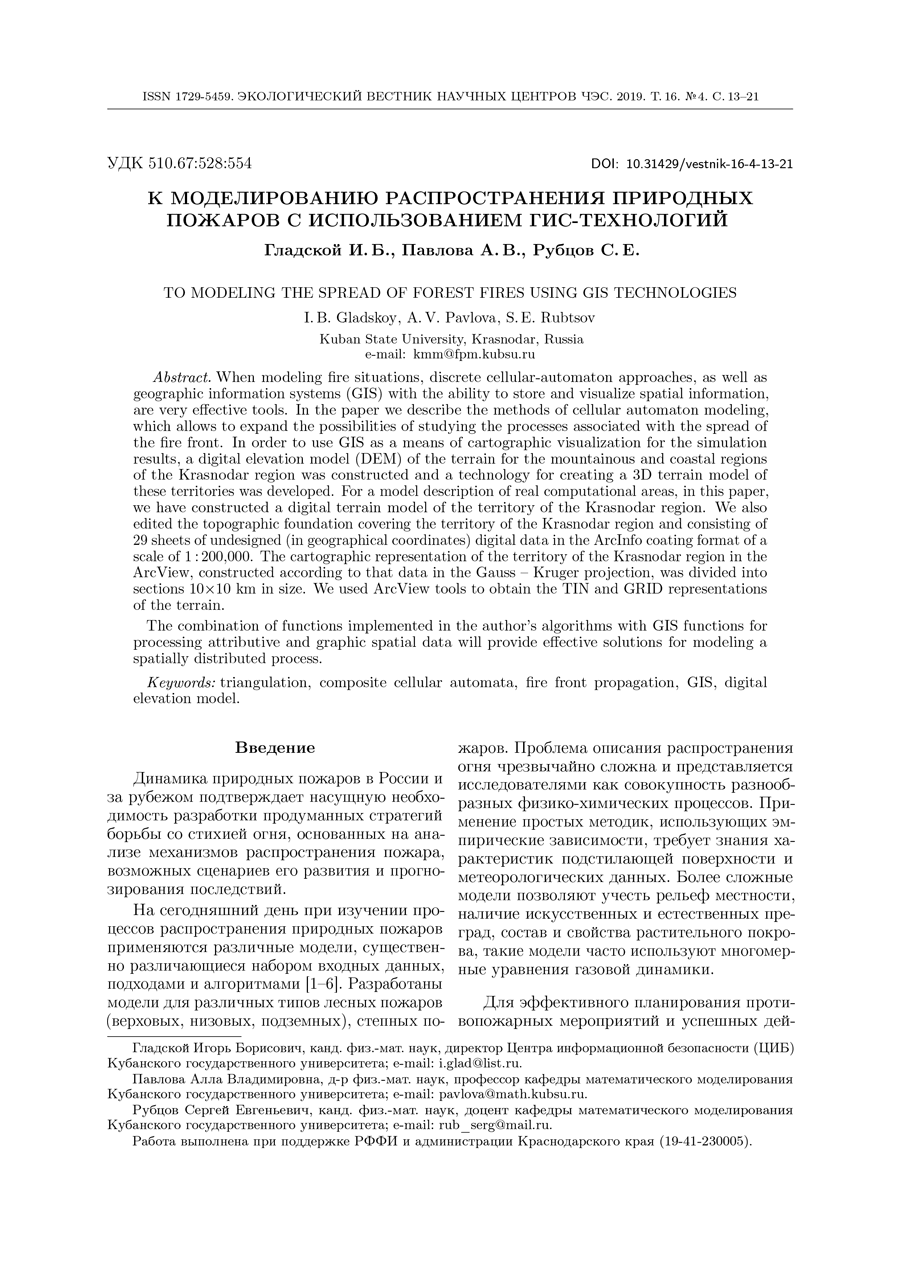To modeling the spread of forest fires using GIS technologies
UDC
510.67:528:554DOI:
https://doi.org/10.31429/vestnik-16-4-13-21Abstract
When modeling fire situations, discrete cellular-automaton approaches, as well as geographic information systems (GIS) with the ability to store and visualize spatial information, are very effective tools. In the paper we describe the methods of cellular automaton modeling, which allows to expand the possibilities of studying the processes associated with the spread of the fire front. In order to use GIS as a means of cartographic visualization for the simulation results, a digital elevation model (DEM) of the terrain for the mountainous and coastal regions of the Krasnodar region was constructed and a technology for creating a 3D~terrain model of these territories was developed. For a model description of real computational areas, in this paper, we have constructed a digital terrain model of the territory of the Krasnodar region. We also edited the topographic foundation covering the territory of the Krasnodar region and consisting of 29~sheets of undesigned (in geographical coordinates) digital data in the ArcInfo coating format of a scale of 1:200,000. The cartographic representation of the territory of the Krasnodar region in the ArcView, constructed according to that data in the Gauss-Kruger projection, was divided into sections 10x10 km in size. We used ArcView tools to obtain the TIN and GRID representations of the terrain.
The combination of functions implemented in the author's algorithms with GIS functions for processing attributive and graphic spatial data will provide effective solutions for modeling a spatially distributed process.
Keywords:
triangulation, composite cellular automata, fire front propagation, GIS, digital elevation modelAcknowledgement
References
- Kourtz, P.H., O'Regan, W.G. A model for a small forest fire to simulate burned andburning areas for use in a detection model. Forest Science, 1971, vol. 17, iss. 2, pp. 163–169.
- Perminov, V.A. Matematicheskoe modelirovanie vozniknoveniya i rasprostraneniya verhovyh lesnyh pozharov v osrednennoj postanovke [Mathematical modeling of the occurrence and propagation of high forest fires in an averaged setting]. ZHurnal tekhnicheskoj fiziki [J. of Technical Physics], 2015, vol. 85, iss. 2, pp. 24–30. (In Russian)
- Asylbaev, N.A. Matematicheskoe modelirovanie rasprostraneniya stepnogo pozhara [Mathematical modeling of the spread of the steppe fire]. Komp'yuternye issledovaniya i modelirovanie [Computer Research and Modeling], 2010, vol. 2, no. 4, pp. 377–384. (In Russian)
- Mysheckaya, E.E. Matematicheskoe modelirovanie lesnyh pozharov s primeneniem mnogoprocessornyh EVM [Mathematical modeling of forest fires using multiprocessor computers]. Matematicheskoe modelirovanie [Mathematical modeling], 2008, vol. 20, no. 11, pp. 28–34. (In Russian)
- Barovik, D.V., Taranchuk, V.B. Algoritmicheskie osnovy postroeniya komp'yuternoj modeli prognoza rasprostraneniya lesnyh pozharov [Algorithmic basis for constructing a computer model for forecasting the spread of forest fires]. Fundamental'nye nauki. Informatika [Fundamental Sciences. Computer science], 2011, no. 12, pp. 51–56. (In Russian)
- Kuzyk, A.D., Karabyn, O.A. Matematicheskoe modelirovanie rasprostraneniya lesnogo pozhara s uchetom vetra i rel'efa [Mathematical modeling of the spread of a forest fire taking into account wind and topography]. Bezpieczeństwo i Technika Pożarnicza, 2013, vol. 32, iss. 4. pp. 107–113. (In Russian)
- Rubtsov, S.E., Pavlova, A.V. Kletochno-avtomatnye modeli diffuzionno-reakcionnyh processov mnogokomponentnyh primesej [Cellular automaton models of diffusion-reaction processes of multicomponent impurities]. Zashchita okruzhayushchej sredy v neftegazovom komplekse [Environmental Protection in the Oil and Gas Complex], 2017, no. 6, pp. 55–60. (In Russian)
- Rubtsov, S.E., Pavlova, A.V., Olejnikov, A.S. Kletochno-avtomatnoe modelirovanie diffuzii mnogokomponentnoj primesi [Cellular automaton modeling of diffusion of a multicomponent admixture]. Ekologicheskij vestnik nauchnyh centrov Chernomorskogo ekonomicheskogo sotrudnichestva [Ecological Bulletin of Research Centers of the Black Sea Economic Cooperation],2017, no. 4, pt. 1, pp. 86–93. (In Russian)
- Pavlova, A.V., Rodionov, P.R., Rubtsov, S.E. K kletochno-avtomatnym modelyam pozharov [To cellular-automaton models of fires]. In Ekologiya. Ekonomika. Informatika. Seriya: Sistemnyj analiz i modelirovanie ekonomicheskih i ekologicheskih system [Ecology. Economy. Computer science. Series: System analysis and modeling of economic and ecological systems], vol. 4. Izd-vo YUNC RAN, Rostov n/D, 2019, pp. 245–251. (In Russian)
- Mitakovich, S.A. Prognozirovanie rasprostraneniya lesnogo pozhara v ArcGIS [Predicting the spread of forest fires in ArcGIS]. GIS: teoriya i praktika. ArcGIS 10.1 [GIS: theory and practice. ArcGIS 10.1] 2012. no. 3 (62). https://www.esri-cis.ru/news/arcreview/detail.php?ID=7818&SECTION_ID=252. (In Russian)
- Finney, M.A. FARSITE: Fire Area Simulator. Model Development and Evaluation. USDA For. Serv. Res. Pap. RMRS-RP-4. 1989.
- Toffolli, T., Margolus, N. Cellular Automata Machines. MIT Press, 1987.
- Bandman, O. Comparative Study of Cellular automata Diffusion Models. Lecture Notes in Computer Science, 1999, vol. 1662, pp. 395–399.
- Evseev, A.A., Nechaeva, O.I. Kletochno-avtomatnoe modelirovanie diffuzionnyh processov na triangulyacionnyh setkah [Cellular automaton modeling of diffusion processes on triangulation grids]. Prikladnaya diskretnaya matematika [Applied Discrete Mathematics], 2009, no. 4, pp. 72–83. (In Russian)
Downloads
Submitted
Published
How to Cite
Copyright (c) 2019 Gladskoy I.B., Pavlova A.V., Rubtsov S.E.

This work is licensed under a Creative Commons Attribution 4.0 International License.




